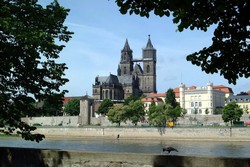IT Infrastructure Modeling Language

Introduction
For software development, there are different graphical modelling languages for different fields of application. As an example, processes can be displayed through event-driven process chains or an object-oriented software can be designed by means of the Unified Modeling Language (UML).
After previous findings, one application area in software development is not yet supported by a standardized graphical modelling language: the modelling of IT infrastructures. In this context, an IT infrastructure is meant to be understood as the unity of all hardware and software resources that are necessary for the introduction and the operation of a software.
Problem
If a software is introduced into an organization, in most cases it is integrated into an existing IT infrastructure. This is especially valid for Very Large Business Applications (VLBAs) since they are applied cross-departmental and cross-organizational.
During the process of planning the intrdocution of the software, the software architect thus finds himself confronted with the following questions:
- Into which IT environment will the new software be integrated? Most of the newly-introduced software products within an organisation are integrated together with other software products. A software architect has to define how the data are transferred from one system to another. This - amongst other things - includes the infrastructural question, in which (different) network segments the particular software products are located and how data can get from one network segment (e.g. DMZ) to another (e.g. LAN).
- How does the staging of developmental systems and production systems process? With the implementation of a new software, initially, a development system, a quality system, and a productive system are installed within organizations in order to conduct organization-specific software modifications . The changes are conducted in the development system, are then checked by testers in the quality system and, after having been sucessfully tested, are transfered to the productive system. This strategy makes sure that there is always a comprehensible productive state of the software and it furthermore contains considerable technical and organizational effort which has to be recorded.
- How can chronologically recurring activities be marked? If e.g. a backup of the data stock is meant to be conducted periodically, this has to be coordinated with the operators of the software (e.g. the employees of the data center) in advance. The voting process could be supported by a graphical modeling language.
Goal
The goal of this research project is the developmentof a graphical modeling language for IT infrastructures. By means of this modeling language, the components of IT-infrastructures and their relations should be modeled. The modeling language is meant to meet all organizational requirements and is thus supposed to close the existing gap between software-architects and software-operators.



